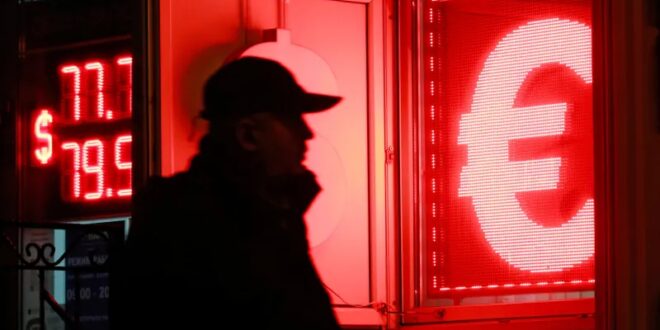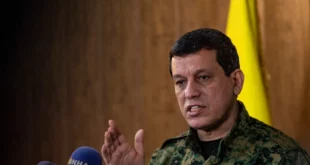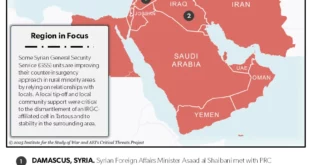Slowly but Surely, They Are Weakening Putin
There is a widespread belief that Western sanctions on Russia have fallen flat. Proponents of this theory point to macroeconomic indicators suggesting that the Russian economy has proved resilient. Critics also highlight how sanctions haven’t had their desired effect: after all, Russian President Vladimir Putin has not moved to end his disastrous war against Ukraine.
These arguments, however, are misguided. It is important to note that Russia had the opportunity to cushion its economy against Western sanctions before Putin declared war. For starters, Russia accumulated substantial financial reserves. Since 2014, Russia has increased trade to Asia, which has allowed it to weather a reduction of commerce with the West. Most important, Putin aggressively strengthened his repressive machine to deter mass protests against deteriorating living standards. For all those reasons, expectations that Western sanctions would cause the Russian economy—and Putin’s regime—to quickly disintegrate were unrealistic.
Putin has invested significant resources in a disinformation campaign aimed at misleading Western policymakers about the real effects of sanctions. But make no mistake: they are, in fact, hobbling the Russian economy. And propagating the myth that they are not effective could nudge policymakers to drop them, giving Putin a lifeline.
BAD DATA
The assertion that the Russian economy has shown remarkable resilience to sanctions hinges on misleading macroeconomic indicators. Specifically, critics of sanctions point to the strengthened ruble, the modest contraction of Russian GDP, and low unemployment. But these figures do not in fact reflect the situation on the ground.
Take unemployment. Official unemployment currently stands at 3.7 percent, with only 2.7 million Russians unemployed. That’s a record low. The reality, however, is that at the end of the third quarter of 2022, almost five million Russian workers were subject to various forms of hidden unemployment. Most notably, 70 percent of them were on unpaid leave. If the difference between being on unpaid leave and being unemployed seems semantic, that’s because it is. In fact, 10 percent of the Russian workforce is without work. This is comparable with the worst levels in the 1990s, during the second half of which 10 to 13 percent of Russians were unemployed.
Another misleading statistic is the ruble exchange rate. True, the ruble has strengthened, but only because the government has made it difficult for Russian businesses and individuals to withdraw money and convert it to foreign currency. The so-called strong ruble is propped up by draconian currency controls and a plunge in imports. This policy has badly hurt industries like the steelmaking sector: finished steel output contracted by over seven percent in 2022.
Policymakers criticizing sanctions point to the Russian Finance Ministry’s projection that the country’s GDP will contract by 2.7 percent, which would seem to undermine the contention that the economy is tanking. Note, however, that this GDP figure includes surging military-related production. A newly produced battle tank immediately sent to the front and shot by a Ukrainian Javelin missile still counts as a nominal contribution to Russian GDP.
Make no mistake: sanctions are, in fact, hobbling the Russian economy.
In any case, other indicators show a far more serious economic contraction than the official GDP figures suggest. Arguably the most revealing indicator of Russian economic activity is revenue from sources other than oil and gas exports, and that figure was down by 20 percent in October 2022 from a year earlier. Manufacturing industries, the part of the Russian economy most dependent on Western technologies and component parts, were hit the hardest by sanctions. The output of the Russian automotive industry, which directly or indirectly provides jobs to 3.5 million people, plummeted by two-thirds in 2022.
Russian figures showing manageable levels of inflation are also misleading. Even the Russian central bank currently reports that observed inflation—that is, how the public views the increase in prices, as reported in surveys—to be 16 percent, or over four percentage points higher than the official statistic, which is a little less than 12 percent. The gap between the official figures and people’s lived experience is understandable because Russians’ living standards are sharply deteriorating. According to a poll released by the private Russian research company Romir in October 2022, 68 percent of Russians had noticed a reduction in the supply of goods offered in stores over the past three months. According to the Russian Public Opinion Research Center, 35 percent of Russians were forced to cut their spending on food in 2022. The Public Opinion Foundation, a Russian polling organization, reported in December 2022 that only 23 percent of Russians considered their personal financial situation to be “good.”
IT’S NOT GETTING BETTER
In sum, sanctions are having a profound effect on the Russian economy. Putin’s attempts to improve his country’s financial prospects include import substitution, or favoring the development of domestic industries and reducing reliance on manufactured imports; redirecting trade and investment flows to Asia; and sourcing semiconductors and other goods from countries such as Turkey to circumvent Western sanctions. None of these approaches will solve Russia’s problems.
Import substitution is not working for obvious reasons. Handing over market share to companies that depend on a highly monopolistic environment invariably leads to inferior goods at higher prices. It does not stimulate innovation or encourage the manufacturing of better products.
Asian countries such as China and India are mostly interested in buying cheap Russian raw materials such as oil, gas, coal, and roundwood at a significant discount. Leaders in those countries are not interested in helping Russia develop its own competitive manufacturing sectors.
Russia was somewhat successful in circumventing sanctions by importing vital Western-produced goods such as parts for manufacturing through third countries, primarily Turkey: by the third quarter of 2022, Russian imports from that country had surged to over $1 billion a month, roughly double the figure from the same quarter the previous year. But Western governments may use diplomatic pressure to close these loopholes. And Putin cannot count on foreign investment to shore up the Russian economy. Capital flight from Russia in 2022 is projected to equal $251 billion, according to the Russian central bank.
All of this is not to say that Putin’s government is on the verge of collapse. Putin destroyed the organized political opposition after he imprisoned the leading dissident, Alexei Navalny, and sent most of Russia’s other most prominent opposition figures to jail or into exile. He has successfully intimidated the Russian population by introducing tough prison terms for those protesting his leadership: Russians face up to 15 years in jail for “political extremism” or “discrediting Russia’s armed forces.”
But public opinion is trending against Putin. As the dissolution of the Soviet Union demonstrates, once long-suppressed public discontent breaks out into the open, change can happen fast. This is why policymakers must give sanctions time to work. Expecting immediate results is unrealistic and even counterproductive. Given time, sanctions may well deter Russia’s aggressive behavior. Western policymakers must conduct a detailed analysis of the impact of sanctions instead of accepting a narrow set of manipulated indicators. And above all, they must be patient.
 Eurasia Press & News
Eurasia Press & News



